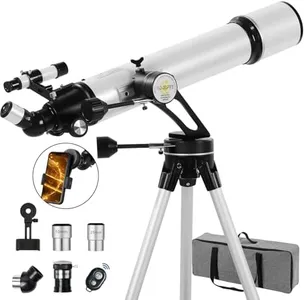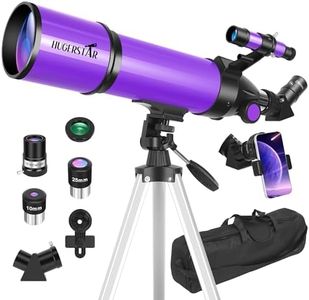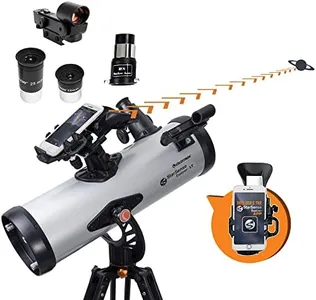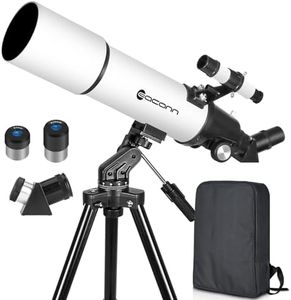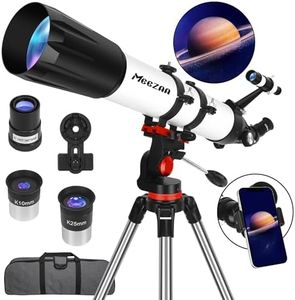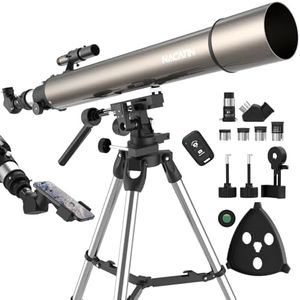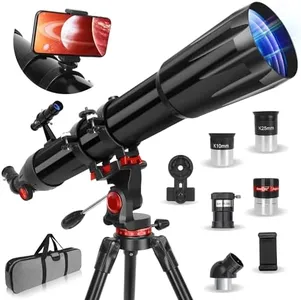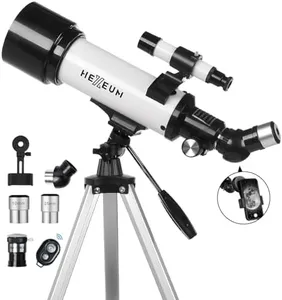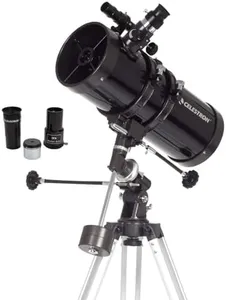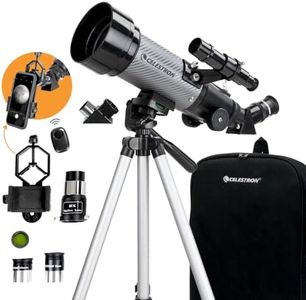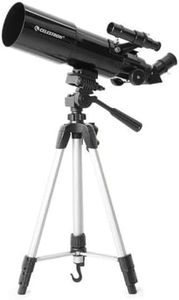10 Best Telescopes For Kids 2025 in the United States
Our technology thoroughly searches through the online shopping world, reviewing hundreds of sites. We then process and analyze this information, updating in real-time to bring you the latest top-rated products. This way, you always get the best and most current options available.

Our Top Picks
Winner
Gskyer Telescope, 70mm Aperture 400mm AZ Mount Astronomical Refracting Telescope for Kids Beginners - Travel Telescope with Carry Bag, Phone Adapter and Wireless Remote.
Most important from
22127 reviews
The Gskyer Telescope is an excellent option for kids and beginners interested in exploring astronomy. With a 70mm aperture and a 400mm focal length, it offers good optical quality, allowing users to enjoy clear views of celestial objects like the moon and stars. Its fully coated optics enhance light transmission, which is essential for a satisfying stargazing experience.
One of the standout features is the included wireless remote and smartphone adapter. This allows young astronomers to take pictures of what they observe, making the experience engaging and educational. The adjustable aluminum tripod adds to its ease of use, providing stability and flexibility in viewing positions.
In terms of portability, the Gskyer Telescope's lightweight design (only 5.7 pounds) and included carry bag make it easy to transport, making it a good choice for family outings or camping trips. The two eyepieces and 3x Barlow lens offer various magnification options, which can keep kids entertained as they learn to locate and observe different celestial objects. The manual focus might be challenging for younger users or those unfamiliar with telescopes, potentially leading to frustration. Additionally, it may not perform well in areas with significant light pollution, which could limit visibility.
Most important from
22127 reviews
Telescope, 90mm Aperture 700mm with Vertisteel AZ Mounting Slow-Motion Mount, High Power for Astronomy Enthusiasts, Easy for Kids, with Carry Bag, Wireless Remote Control, Phone Adapter,White
Most important from
812 reviews
The Koolpte VAZ90700 telescope is a solid choice for kids and beginners eager to explore the night sky. Its 90mm aperture and 700mm focal length deliver impressive optical performance, allowing users to observe a variety of celestial objects with magnification options ranging from 28x to 210x. This makes it suitable for both casual stargazing and more detailed astronomical observation. The telescope’s Altazimuth mount ensures smooth movement, enabling precise adjustments for optimal viewing. This feature is especially beneficial for children learning to use a telescope, as it allows for easy tracking of objects in the sky.
Portability is a significant strength of this model. Weighing just over 12 pounds and designed to be compact, it comes with a carrying case, making it easy to transport to parks or backyards for stargazing sessions. The user-friendly setup means that even children can assemble it quickly, which can enhance their interest in astronomy.
However, there are a few drawbacks to consider. While the optical performance is commendable, some users might find that it requires a bit more patience to perfect the focus, especially if they are very new to telescopes. Additionally, while the wireless remote and phone adapter are convenient features for capturing images, relying on technology might not be necessary for all users, particularly young ones just beginning their exploration. In terms of durability, while it’s designed to withstand regular use, care must be taken to avoid dropping it or exposing it to harsh weather conditions. The manual focus may present a learning curve for very young kids, but with guidance, they can adapt.
Most important from
812 reviews
HUGERSTAR Telescope, Telescope for Adults & Kids & Astronomy Beginners, 80mm Aperture 600mm Portable Refractor Telescopes Fully Multi-Coated Optics with AZ Mount Tripod, Phone Adapter and Moon Filter
Most important from
256 reviews
The HUGERSTAR Telescope is a solid choice for kids and beginners interested in astronomy and nature observation. Its 80mm aperture offers bright and clear views, which is great for seeing the moon, wildlife, and landscapes. The magnification range, from 24X up to 180X using included eyepieces and a Barlow lens, is versatile enough for various activities without overwhelming new users. The altazimuth mount is simple to operate, making it easier for kids to point and track objects in the sky.
Portability is another strong point: it’s lightweight (about 6 pounds) and comes with a carry bag, so it’s convenient for backyard stargazing or outdoor trips. Setting it up is straightforward and quick, usually done within 10 minutes, which helps maintain enthusiasm for young learners. The included phone adapter allows capturing moments, adding fun and practicality. The moon filter improves viewing comfort by reducing glare. One downside is the fixed focus type, which might limit sharpness adjustment compared to more advanced models, but this keeps it less complicated for kids. The aluminum tripod is sturdy but can feel a bit light if used in windy conditions.
This telescope balances ease of use and decent optical performance, making it a friendly introduction to astronomy without overwhelming beginners.
Most important from
256 reviews
Buying Guide for the Best Telescopes For Kids
Choosing a telescope for kids can be a fun and educational experience. The right telescope can spark a lifelong interest in astronomy and science. When selecting a telescope for a child, it's important to consider ease of use, durability, and the ability to provide clear and enjoyable views of the night sky. Here are some key specifications to consider when picking the best telescope for a young astronomer.FAQ
Most Popular Categories Right Now


